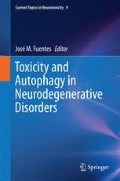Abstract
Huntington’s disease (HD) is a hereditary neurodegenerative disorder characterized by motor, cognitive and behavioural abnormalities. HD is caused by a mutation in the huntingtin gene which produces an enlarged chain of CAG triplets in this gene and an expanded chain of poliglutamines in the N terminal portion of the protein. HD is characterized by neuronal loss and atrophy of several brain nuclei, preferentially in the striatum.
The pathogenic mechanisms responsible for HD are partially unknown. Mutant huntingtin aggregates in insoluble filaments, changes its localization from the cytoplasm to the nucleus and changes the transcription of genes, inhibits mitochondrial function, activates caspases, block microtubules, interacts with Ca2 + channels and excitatory receptors and inhibits the production of neurotrophic factors.
There are abnormalities of the ubiquitin proteasomal system (UPS) in HD. In samples of human brain from patients with HD, it has been observed that there are intranuclear inclusions of huntingtin fragments which stain with antibodies against ubiquitine. These inclusions are present even before the presence of clinical deficits and their severity correlates with the size of the expansion. Proteasomal function, however, is preserved suggesting that the polyglutamine chains block the ubiquitylation pathway. In human fibroblasts from patients with HD, activation of autophagy compensates the deficits of the UPS .
Similarly, in experimental models of HD there are intraneuronal inclusions which appear before the clinical deficits and stimulation of the autophagy reduces the number of inclusions. Autophagy could compensate deficits related with blockade of the UPS in HD.
Access this chapter
Tax calculation will be finalised at checkout
Purchases are for personal use only
References
Bruyn GW, Went LN. Huntington’s chorea. In: Vinken BG, Vinken PJ, Klawans HL, editors. Handbook of clinical neurology. Amsterdam: Elsevier; 1986. pp. 267–97.
Huntington G. On chorea. In: Butler PSW, editor. The medical and surgical reporter: a weekly journal. 1872. pp. 317–21.
Ruiz PJ, et al. Huntington’s disease: a multidisciplinary study. Eur J Neurol. 1995;2(3):185–91.
Gusella JF, MacDonald ME. Hunting for Huntington’s disease. Mol Genet Med J Neurol. 1993;3:139–58.
Gusella JF, et al. A polymorphic DNA marker genetically linked to Huntington’s disease. Nature. 1983;306(5940):234–8.
Vonsattel JP, Keller C, Cortes Ramirez EP. Huntington’s disease—neuropathology. Handb Clin Neurol. 2011;100:83–100.
Roze E, et al. Pathophysiology of Huntington’s disease: an update. Rev Neurol (Paris). 2008;164(12):977–94.
Vonsattel JP, DiFiglia M. Huntington disease. J Neuropathol Exp Neurol. 1998;57(5):369–84.
Ross CA. Huntington’s disease: new paths to pathogenesis. Cell. 2004;118(1):4–7.
Perutz M. Polar zippers: their role in human disease. Protein Sci. 1994;3(10):1629–37.
DiFiglia M, et al. Aggregation of huntingtin in neuronal intranuclear inclusions and dystrophic neurites in brain. Science. 1997;277(5334):1990–3.
Gutekunst CA, et al. Nuclear and neuropil aggregates in Huntington’s disease: relationship to neuropathology. J Neurosci. 1999;19(7):2522–34.
Li X, et al. Inhibiting the ubiquitin-proteasome system leads to preferential accumulation of toxic N-terminal mutant huntingtin fragments. Hum Mol Genet. 2010;19(12):2445–55.
Metzger S, et al. Age at onset in Huntington’s disease is modified by the autophagy pathway: implication of the V471A polymorphism in Atg7. Hum Genet. 2010;128(4):453–9.
Metzger S, et al. The V471A polymorphism in autophagy-related gene ATG7 modifies age at onset specifically in Italian Huntington disease patients. PLoS One. 2013;8(7):e68951.
Fernandez-Estevez MA, et al. Trehalose reverses cell malfunction in fibroblasts from normal and Huntington’s disease patients caused by proteosome inhibition. PLoS One. 2014;9(2):e90202.
Wu JC, et al. The regulation of N-terminal Huntingtin (Htt552) accumulation by Beclin1. Acta Pharmacol Sin. 2012;33(6):743–51.
Sarkar S, et al. Small molecules enhance autophagy and reduce toxicity in Huntington’s disease models. Nat Chem Biol. 2007;3(6):331–8.
Tsvetkov AS, et al. A small-molecule scaffold induces autophagy in primary neurons and protects against toxicity in a Huntington disease model. Proc Natl Acad Sci U S A. 2010;107(39):16982–7.
Williams A, et al. Novel targets for Huntington’s disease in an mTOR-independent autophagy pathway. Nat Chem Biol. 2008;4(5):295–305.
Mealer RG, et al. Rhes, a striatal-selective protein implicated in Huntington disease, binds beclin-1 and activates autophagy. J Biol Chem. 2014;289(6):3547–54.
Ravikumar B, et al. Inhibition of mTOR induces autophagy and reduces toxicity of polyglutamine expansions in fly and mouse models of Huntington disease. Nat Genet. 2004;36(6):585–95.
Reddy PH, et al. Behavioural abnormalities and selective neuronal loss in HD transgenic mice expressing mutated full-length HD cDNA. Nat Genet. 1998;20(2):198–202.
Yu ZX, et al. Mutant huntingtin causes context-dependent neurodegeneration in mice with Huntington’s disease. J Neurosci. 2003;23(6):2193–202.
Myers RH, et al. False-negative results with levodopa for early detection of Huntington’s disease. N Engl J Med. 1982;307(9):561–2.
Myers RH, et al. Homozygote for Huntington disease. Am J Hum Genet. 1989;45(4):615–8.
Sapp E, et al. Early and progressive accumulation of reactive microglia in the Huntington disease brain. J Neuropathol Exp Neurol. 2001;60(2):161–72.
Bradford J, et al. Mutant huntingtin in glial cells exacerbates neurological symptoms of Huntington disease mice. J Biol Chem. 2010;285(14):10653–61.
Shin JY, et al. Expression of mutant huntingtin in glial cells contributes to neuronal excitotoxicity. J Cell Biol. 2005;171(6):1001–12.
Tydlacka S, et al. Differential activities of the ubiquitin-proteasome system in neurons versus glia may account for the preferential accumulation of misfolded proteins in neurons. J Neurosci. 2008;28(49):13285–95.
Perucho J, et al. Striatal infusion of glial conditioned medium diminishes huntingtin pathology in r6/1 mice. PLoS One. 2013;8(9):e73120.
Acknowledgements
The authors thankfully acknowledge the support of CIBERNED and CAM grants (PI: Dr. MA Mena) and the help of Mrs. C. Marsden with the editing of the manuscript in English.
Author information
Authors and Affiliations
Corresponding author
Editor information
Editors and Affiliations
Rights and permissions
Copyright information
© 2015 Springer International Publishing Switzerland
About this chapter
Cite this chapter
Mena, M., Perucho, J., Fernandez-Estevez, M., Yébenes, J. (2015). Autophagy Pathways in Huntington’s Disease. In: Fuentes, J. (eds) Toxicity and Autophagy in Neurodegenerative Disorders. Current Topics in Neurotoxicity, vol 9. Springer, Cham. https://doi.org/10.1007/978-3-319-13939-5_5
Download citation
DOI: https://doi.org/10.1007/978-3-319-13939-5_5
Published:
Publisher Name: Springer, Cham
Print ISBN: 978-3-319-13938-8
Online ISBN: 978-3-319-13939-5
eBook Packages: Biomedical and Life SciencesBiomedical and Life Sciences (R0)

